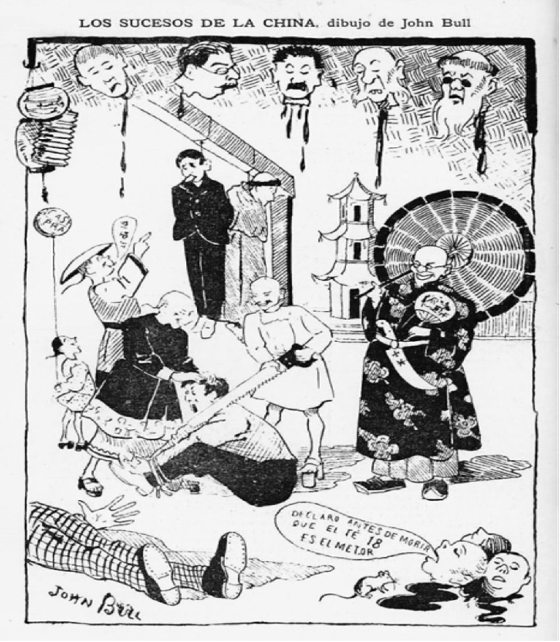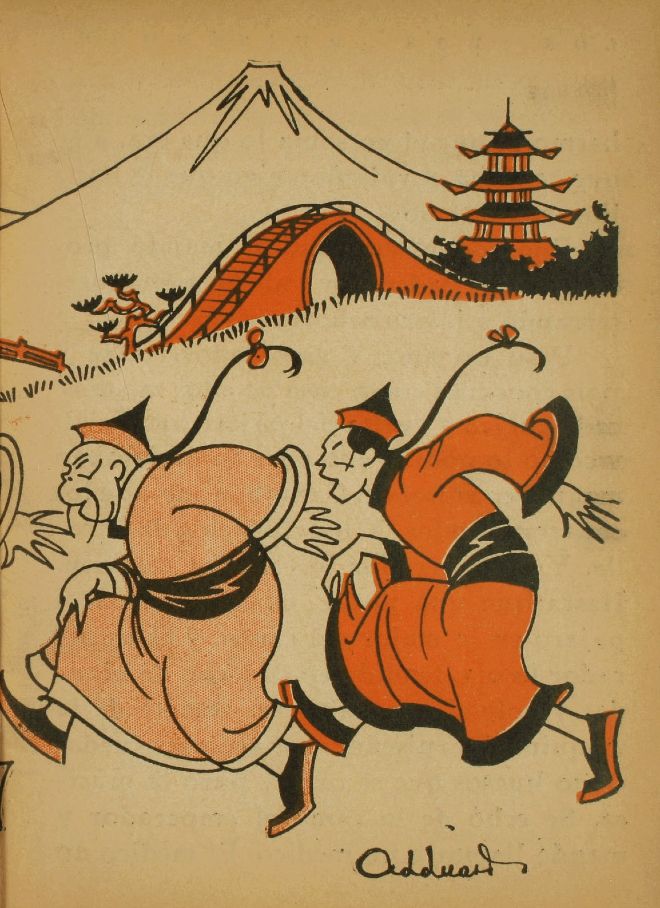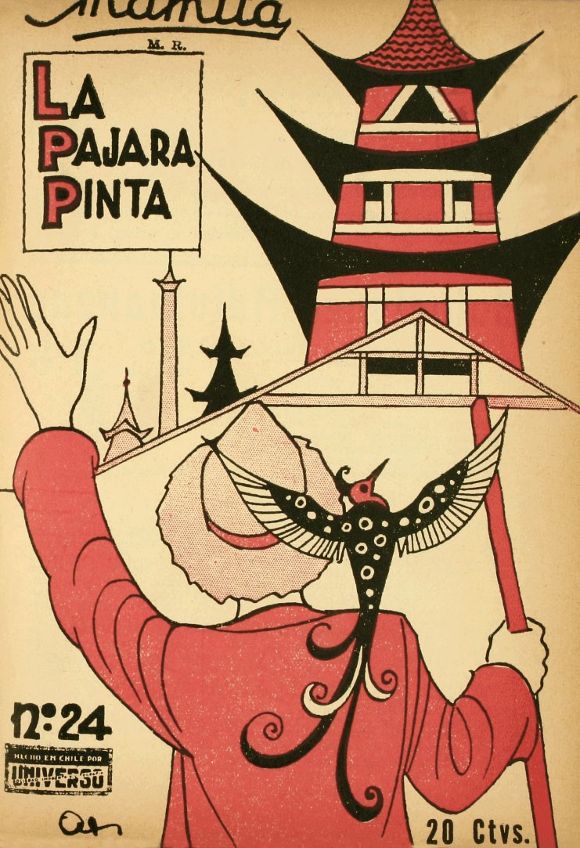FEATURES|THEMES|Books and Literature
God of the Unknown: The Buddha in Chilean Magazines at the Turn of the 20th Century
The following is a translation of an article originally published in Buddhistdoor en Español.
A little shop full of odds and ends concealed the shrine. The shrine was murky and dim, covered entirely in red silks, with a smattering of gold-embroidered Chinese characters. On the door, a lantern cast a dim light, whose flickering shrouded the outlines of things, making them appear odd and surreal. The figure of the Buddha could be discerned in the background, faded colors on a silk cloth, inscrutable, with crossed legs, hands on his chest and his face impassive. (“En el país de Fu-Sang” by Sady Zañartu, Zig-Zag, 22 August 1925)
A Buddha, sitting among red silks, is the main character in this story narrated by the Chilean writer, which appeared at the turn of the 20th century in the pages of an extremely popular magazine of the day, Zig-Zag. The story creates an ambience in which the Buddha rests on a home altar, in a house nestled among the dark streets of the Peruvian city of Tacna, revealing the Orientalist awakening and interest that was already flooding the collective imagination on this side of the South American continent.
The conceptions surrounding Buddhism reached Chile in the same way as other Asian religions and philosophies. They were introduced via spiritual movements from Europe, nourished by eclectic thought that was amassed through a series of doctrines. Prominent among these was the Theosophical Society, established in 1875 and founded in Chile in 1919, merging a series of theosophical study groups, which had formed in the cities of Valparaíso and Santiago. (Luarte 2019) While these new movements opened up spiritual possibilities and understandings that differed from traditional ideas, they also transferred Orientalist depictions of the Asian world that infused ideas of the Buddha and Buddhism. Travelers’ stories must be added to this influence, along with literature and foreign tales translated and published in magazines that appeared in Chilean society. This article analyzes representations of Buddhism and associated items that are found in publications at the beginning of the 20th century. Representations of Buddhism appeared as “Asian” culture, with Asian people as “children of the Buddha,” including or even highlighting its warlike aspect, or as part of an idea of a monotheist religion surrounding the Buddha, associated with ideas of kindness and benevolence or, conversely, with violence and brutality.
The polarity that can be glimpsed among this imagery of the Buddha is quite odd, as it swings between ideas of a mysterious, exotic, and dark character with particularly violent religious practices, and a savior “god” who protects and gives blessings. The examples mentioned here could be read in articles published in magazines in Chile in the early 20th century, which were created in a communicational transformational period with heterogeneous readers. (Ossandon and Santa Cruz, 2005; Rinke 2002) These magazines played an essential role in conveying news and social and cultural events to Chilean society.
Let’s return to Zañartu’s story, which recounts the murder of a woman and in which the accused is a Buddhist missionary, Juan Shin, who allegedly committed the crime for the Buddha, so that the victim could be “the first person saved for his paradise.” Titled “In the Country of Fusang,” it combines legendary elements of Fusang or Fu-sang that—according to the centuries-old theory by French sinologist J. de Guignes—refers to the name that the Buddhist monk Huishen used to refer to the Americas, which he visited in the fifth century. While both the discussion of this story and the origins of the word Fusang are fascinating (see Maeth Ch. 1990), the purpose of this article goes beyond the implausibility of the story of Huishen, which Zañartu employed to create a story in which Juan Shin refers to the alleged arrival of the “prophet” on American lands to “spread the mysteries of his religion:”
. . . combines features of the violent acts among the creation of rites in Orientalist mysticism, adorned with the Chinese aesthetic, with red lanterns, the smell of opium, dim lights and shadows of silhouettes. Zañartu’s story reveals the aforesaid aspects of the era’s imaginary of China, including references to fictitious religious practices, creating a story in which the murder of women is tied to sacrificial rites to the Buddha. (Ríos, Montt, Chan 2021)
The perverse character of Juan Shin and the Buddha as an evil god allowing cruel rites is read in other stories. One of them is titled “The Manufacture of Human Monsters in China,” in La Revista Nueva, Volume II, 1900, which is a translation of a text published by J. Drexelias in the Mercure de France. As the title implies, the article describes a series of horrifically injurious practices, which emphasize extreme “Chinese torture,” feeding the imagination of what is Chinese. Until today, it continues to be conceived as “Asian” (see Montt 2017), propagating the idea of an exceptionally violent people. The text reads: “Burning over a slow flame, skinning while alive are tortures invented by political or religious hatred.” The ending adds:
It seems like privation of light is enough to convert a child into quite an odd monster, especially if he is fed with special foods and his vocal cords are atrophied. That is how living Buddhas are produced that the Buddhist monks (priests) exhibit before the pious multitudes. A child, after spending long years in absolute darkness, became luminously white, almost like snow. He was also forced to remain immobile throughout this time, in the well-known posture of the Buddhas. They never spoke to him and completely ignored him. In the end, the child was in an almost vegetative state, a type of living mushroom. Exhibited to the faithful, this lump of flesh with shining eyes was venerated by the masses (La Revista Nueva, Volume II, 1900, 122)
It is highly likely that what the author intended to describe was sokushin jōbutsu, translated as the attainment of buddhahood in this very body, a practice done in Japan by monks who decided to live in extreme asceticism and achieve mummification of their bodies. While this practice was banned in the country, the contents described here speak of a brutal rite to children, as figures to exhibit, which leads to disproportionate and erroneous information, replete with horrifying descriptions.
An image that depicts this dark idea of Buddhism that is indirectly espousing violent action can be found in an advert for “Té 18,” in Sucesos magazine from 1900. The illustration portrays a satirical episode in the context of the Boxer Rebellion and international powers. A pagoda (stupa) can be seen in the background, a Buddhist symbol in which the relics of buddhas or eminent masters were safeguarded, recalling one of the most important precepts of Buddhism—ahimsa—or non-violence. (Ríos, Montt Strabucchi and Chan 2021, 138)

Sucesos magazine, 22 July 1900. Image courtesy of the author
The depiction of a pagoda also heeds imagary of the Asian East, since, beyond an understanding of a pagoda as a Buddhist building, it is primarily conceived as a symbol of Chinese (or Asian) culture, which would be drawn in diverse images that aimed to represent an “Oriental” space. Further examples, also from this period, are these illustrations from two stories published in children’s magazines:

Mamita magazine, “The Two Nightingales," 10 July 1931.
Image courtesy of the author

Mamita, “La pájara pinta," 19 November 1931.
Image courtesy of the author
With respect to the Buddha and returning to the reckless figure who endorses the cruelty of his religious practices, we can read other writings in which he is described as the “father” who encourages the warlike behavior of his children:
And Europeans already know through experience what the yellow race can do after it learns to handle its own weapons, everything the Buddha’s son is capable of once science and the incomparable effort of his blood are put into operating large industrial machines or machines for modern destruction. (Zig-Zag, 6 January 1907: “El despertar de la China”)
This paternal and protective conception is also described as the divine figure to whom you must prey, which is close to the devotion existing to the Buddha in Asia, mainly in Pure Land devotion to Amida Buddha, but who takes on a role much closer to the Christian God in these articles. Another story published in Sucesos magazine in 1914 was “The Legend of Silk,” in which an empress, desperate because of the hunger her people are suffering, receives protection from the Buddha:
Oh Queen, said the visitor. Buddha has heard your prayers and your virtue and charity have touched his heart. I had a prophetic dream and from a dark forest on a rock inaccessible to curious mortals, I built my home and I have come to bring you the good news. The sovereign took the male saint’s hand and kissed it. Tomorrow – continued this singular character—dress simply, wear travelling shoes and, accompanied by two of your most robust maidens, leave at the first sign of dawn to travel through the fields surrounding your Capital. Buddha shall guide your steps and trust what an old woman will tell you who, without ever having seen you before, will recognize your noble birth. The sovereign understood that she had fulfilled the Buddha’s wishes and that the work in which she had helped for several weeks would be the redemption of her people. She kneeled down and gave thanks to the divinity. (Sucesos, 17 December 1914: “The Legend of Silk” [industrial literature])
The story contains descriptions such as “may the Buddha protect them,” “she had fulfilled the Buddha’s will,” and “it was the Buddha’s compassion,” all of which were addressed to the “Buddha God,” as he is described in a travel tale titled “Domestic life in a Buddhist temple” (Selecta, 1909) or “Holy Buddha” from the story “The Heart of a Geisha” from Selecta (1910). These phrases that indicate the Buddha’s benevolence and compassion situate Buddhism as a monotheistic religion, with an absolute god who listens to his devotees’ prayers: a somewhat Mahayana tendency, but with a clear influence from the soteriological rhetoric and understanding of Christianity.
In conclusion, the figure of the Buddha read in magazines published during the early decades of the 20th century is seen to be a “god of the unknown,” alluding to this term in relation to the idea of “strange encounters” described by Sara Ahmed, which takes on relevance in Orientalist studies in Chile. (Montt, 2017) A god, the father who, on the one hand, is surrounded by a dark and mysterious environment, with savage rites, who leads his “children” in violent warlike actions, and, on the other, this all-powerful divine being who listens to prayers and helps those most in need.
María Elvira Ríos is a doctor in Asian and African studies, specializing in China, from the Centre of Asian and African Studies at El Colegio de México (2015). She is a member of ALADAA CHILE (Latin American Association of Asia and Africa). Her publications address subjects related to contemporary Chinese Buddhism and Chinese culture and language. Her studies have been published in numerous academic journals. She currently teaches the course Buddhist Aesthetics at the Institute of Aesthetics at the Pontifical Catholic University of Chile and is a Fondecyt postdoctoral fellow (3190076) at the same institution, where her dissertation is entitled “The ecological reflection of Chinese Buddhism.”
References
Ahmed, Sara. 2000. Strange Encounters: Embodied Others in Post-Coloniality. Abingdon-on-Thames, Oxfordshire: Routledge.
Ossandón, Carlos and Santa Cruz, Eduardo (with Ávila, P. and Santa Cruz Grau, L.E). 2005. El estallido de las formas. Chile en los albores de la “cultura de masas”. LOM, Universidad Arcis.
Luarte, Felipe. 2019. “Una aproximación histórica al (Neo-) Hinduismo en Chile,” Nuevos diálogos: Asia y África desde la mirada latinoamericana (Ríos, Maire, Álvarez, et al.), Mexico City: Mexico City College.
Montt Strabucchi, Maria. 2017. “Imagining China in Contemporary Latin American Literature.” PhD thesis. University of Manchester.
Rinke, Stefan. 2002. Cultura de masas: reforma y nacionalismo en Chile 1910–31. Dirección de Bibliotecas, Archivos y Museos.
Ríos, Maria Elvira, Montt Strabucchi, Maria, and Chan, Carol 2021. El imaginario de lo chino en las revistas magazinescas chilenas de principios del siglo XX, Rumbos TS, year XVI, No. 24, pp. 129–50.
Maeth Ch, Russell. 1990. Nuevos estudios sobre el problema de Fu-Sang. Estudios de Asia y África, XXV: 3, pp. 461–88.
Related features from Buddhistdoor Global
Fo Guang Shan’s Never-ending Work in Chile
Growing Pains, Budding Flowers: The Hispanic Association of Buddhism
Dharma in Translation: Lhundup Damchö
The Tara Garden at Chagdud Gonpa Khadro Ling, Brazil
Un Buda - An Argentinian Vision of Buddhism














